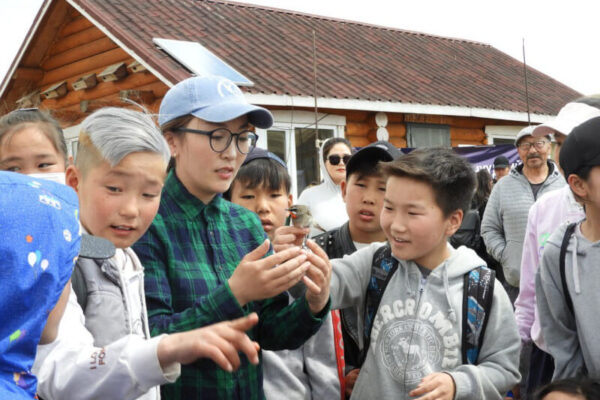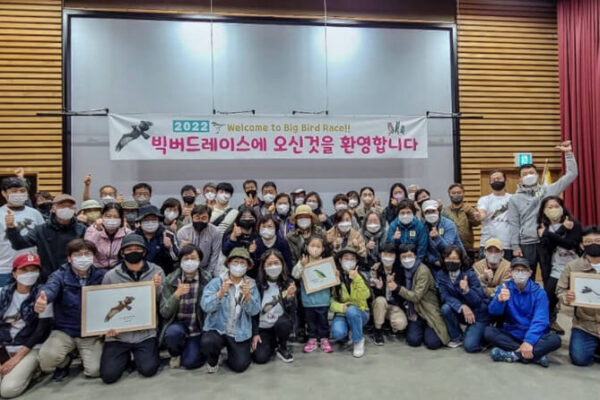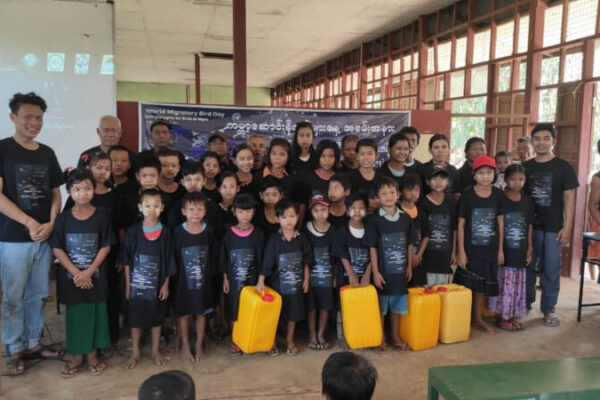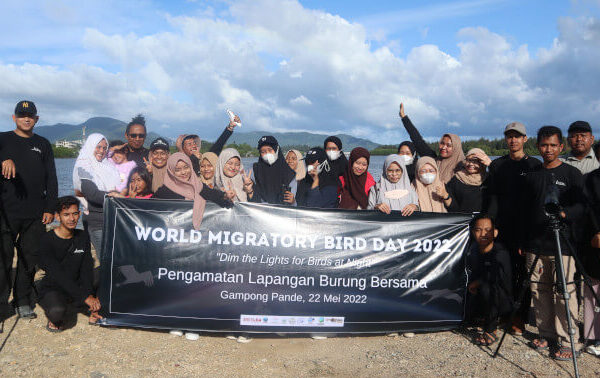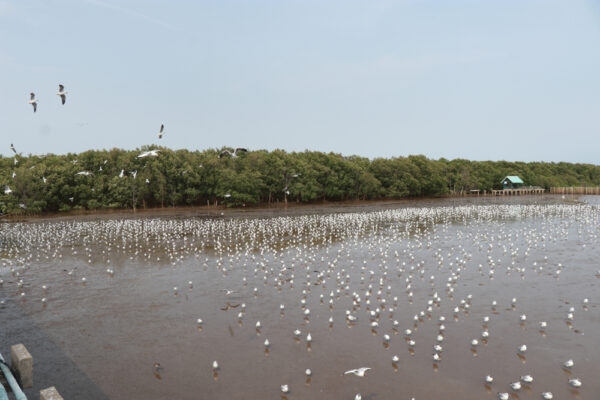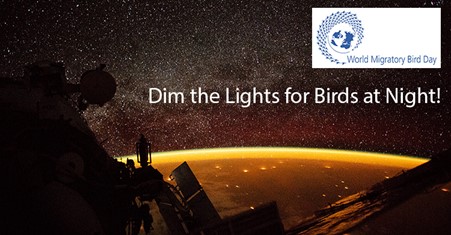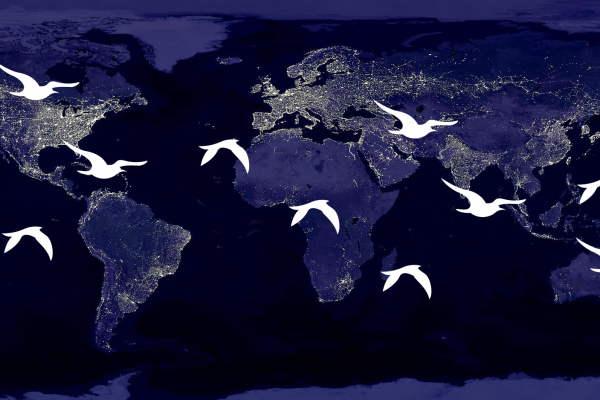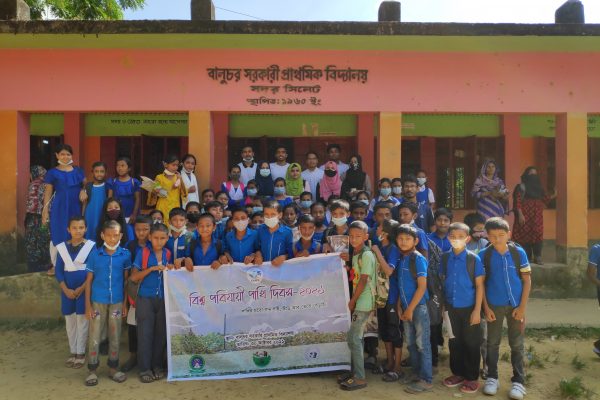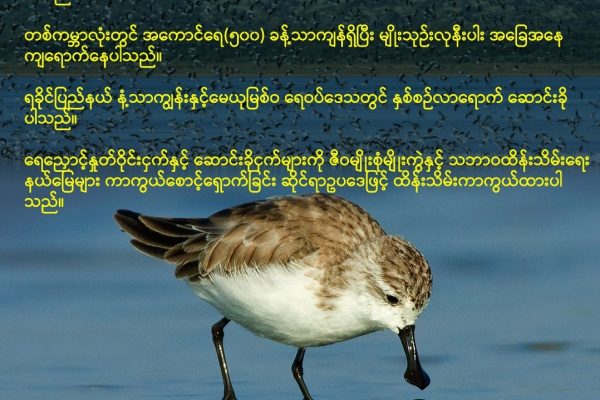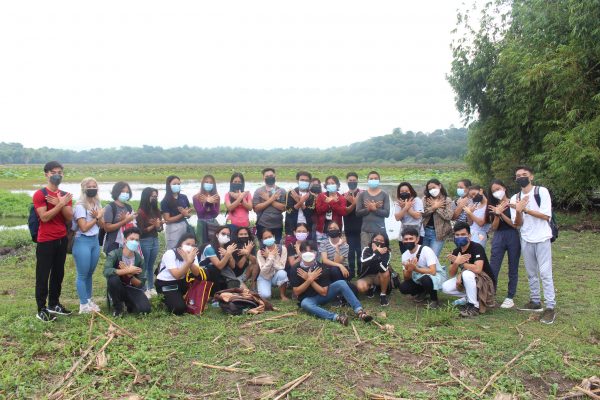-
2022 World Migratory Bird Day Celebration in West, South and Eastern Mongolia
The celebration of World Migratory Bird Day (WMBD) 2022 in Mongolia by Wildlife Science and Conservation Center (WSCC) in West, South and Eastern Mongolia was a success. WSCC, Mongolia has been celebrated WMBD since 2010s by small grants or organization’s own funds every year with various public awareness activities following each year’s WMBD theme and slogan. Demo talk how to use opticals, Southern Mongolia ©️ Wildlife Science and Conservation Center - Mongolia The celebration was organized between 12 – 20 May in Western, Eastern and Southern Mongolia, supported by EAAFP WMBD small grant and cooperation with WWF Mongolia, Oyu Tolgoi LLC, and high schools of every soum (area of pastureland) in the vicinity. All three sites were very special places for migratory birds and thus, it is very important to involve local kids and teachers to explain the bird species around the home. Students bird watching, Western Mongolia ©️ Wildlife Science and Conservation Center - Mongolia Demonstration talk of how, why we ring birds, Western Mongolia ©️ Wildlife Science and Conservation Center - Mongolia Over 910 participants have been reached out through this event to share about bird research and migratory birds’ conservation, especially how to deal with light pollution to protect migratory birds and other animals. Many of the school students joined this kind of activities for the first time to learn about WMBD, and they would keep this memory of the event in their hearts. Releasing Siberian Rubythroat, Eastern Mongolia ©️ Wildlife Science and Conservation Center - Mongolia Two competitions, birdwatching competition and bird drawing competition, were very attractive to all kids, and they enjoyed learning about birds and bird migration through these two competitions. Most importantly, the two ringing stations also tremendously aided in the learning - on bird study and conservation - for all attendees and their knowledge have greatly strengthened for their future, proven by the fact that several students have been started volunteering as an assistant ringer position when they have free time afterschool. Children heading out for the bird ringing activity, Eastern Mongolia ©️ Wildlife Science and Conservation Center - Mongolia Drawing competition in progress at the Khurkh BRS, Eastern Mongolia ©️ Wildlife Science and Conservation Center - Mongolia Information leaflets were distributed among all participants in E and Western Mongolia. A total 12 winners of two competitions were rewarded with education materials such bird guidebook and wildlife conservation related books and painting materials. Presentations in Western Mongolia ©️ Wildlife Science and Conservation Center - Mongolia In the Western Mongolian activities were supported by WWF Mongolia, and they helped us with arranging education materials and rewards for the contest winners. Mongolian Bird Watching club members celebrated Global Big Day on 14 May as well, Team Mongolia observed 254 species in 24 hours, and was one of the biggest successes among the team members. They are very proud of their bird’s species diversity and were encouraged by our results which was 4th place in the Asia and 16th place in the world team rank. Many young members of the Team Mongolia were motivated for bird watching and delighted by our team efforts for Global Big Day. Students birdwatching, Southern Mongolia ©️ Wildlife Science and Conservation Center - Mongolia Team recording what they saw, Southern Mongolia ©️ Wildlife Science and Conservation Center - Mongolia Article prepared by Mongolia by Wildlife Science and Conservation Center (WSCC).
Continue reading -
Ganghwa Big Bird Race for 2022 World Migratory Bird Day
From 30 April to 1 May 2022, the <Ganghwa Big Bird Race> was organized by Moolsaeal, a local NGO, on Ganghwa Island, Republic of Korea. A total of 26 teams, 110 birdwatchers from across the country (14 competitive, 12 non-competitive) spent 24 hours searching for birds in Ganghwa Island. Unlike normal birding competitions, all birds observed must be photographed and uploaded to a monitoring App called 'Getbol keepers'. With the records listed on this monitoring App, the judges score and rank them. The competition, which began with a congratulatory greeting from EAAFP Chief Executive Mr. Doug Watkins, followed by the lectures introducing Ganghwa birding places and instructions of the race. The BBR then kick-started in the heated atmosphere. Group Photo of Participants and Organization Committee ©️ 2022 Ganghwa Big Bird Race Organization Committee Families and EAAFP secretariat staff, who participated in the non-competition section, then attended a lecture by the organizer to learn about common bird species. Then they visited rice paddies and mudflats with professional birding guides for bird watching. At the end of the first day, there was a music performance to celebrate the event, followed by a sharing section in which all the teams were introduced and expressed their feeling for joining the Ganghwa BBR. Families participating in the non-competitive Birdwatching section ©️ 2022 Ganghwa Big Bird Race Organization Committee EAAFP Secretariat Staff at Ganghwa BBR ©️ 2022 Ganghwa Big Bird Race Organization Committee During the BBR, teams observed a total of 581 photo records and 102 bird species for two days. The first-place team scored 75 points (69 records + 6 additional points for protected species), the second-place team scored 56 points (51 records + 5 additional points for protected species), and the third-place team scored 55 points (51 records + 4 additional points for protected species). Participants for the competitive section ©️ 2022 Ganghwa Big Bird Race Organization Committee Families participating in the non-competitive section ©️ 2022 Ganghwa Big Bird Race Organization Committee Some sharing from the participants:Mr. Rahul Teku Vaswani and his family, from India, saw a black-faced spoonbill biting a giant frog and said, “It’s so amazing. The colors and patterns made by nature are really beautiful.” Another participant said, "There were not many birds this year. Continuous monitoring is needed, whether it is due to climate change or other environmental factors. We expect more people to participate next year.” For more on Ganghwa BBR (in Korean) https://ghbbr.modoo.at/?link=cgfdi6ow Article prepared by Moolsaeal.
Continue reading -
Celebrating 2022 World Migratory Bird Day in Villages near the Gulf of Mottama, Myanmar
Group photo of the participants to the WMBD 2022 at GoM ©️ NCS On 10 May 2022, Nature Conservation Society-Myanmar (NCS) organized the World Migratory Bird Day(WMBD) event for 2022 in Basic Education Primary School, Koe Tae Su Village, Belin Township near Gulf of Mottama(GoM) in Myanmar with financial support from EAAFP WMBD Small Grant Fund. The purpose of organizing this event was to raise awareness in local communities on how WMBD was formed and held annually all around the world, and to educate the local communities about the importance of the conservation of migratory birds and wetland ecosystems. A total of 104 participants joined the event and most of participants were school students and local communities from villages around GoM. Members of Local Conservation Groups (LCG) from Koe Te Su village have also joined the event. Presentation on WMBD and the theme, Light Pollution©️ NCS The event started with visual presentations about the history of WMBD, annual celebrations, the theme of this year - light pollution, and migratory shorebirds, wetland conservation and Ramsar sites were presented. The “Migratory Bird” song and video clips of the six EAAFP Flyway Network Sites in Myanmar and light pollution were shown. The team presented the mangrove forest status and its conservation in Myanmar. Quiz and games were included in the event with an online platform, covering the critically endangered Spoon-billed Sandpiper (SBS), light pollution and migratory birds. the. Questions were shown on the screen and participants were encouraged to the answer quickly. The participants whowere the first to answer correctly won prizes. School students aged between 5 and 10 played the Spoon-billed Sandpiper (SBS) finding game and kids who could find the greatest number of SBS were awarded. Kids playing the Spoon-billed Sandpiper finding game ©️ NCS Awarding participants who could answer the quiz ©️ NCS Local communities and students were more aware of the theme of WMBD for this year especially the value of the natural dark, increasing light pollution, the impacts of the light pollution on migratory birds and nocturnal animals. They also learned about the six Ramsar sites in Myanmar and their importance in their livelihoods. Participants have also observed the conservation status of the threatened species including the Critically Endangered Spoon-billed Sandpiper that migrate to the Gulf of Mottama and the efforts of local and international organizations working for the conservation. The audience were fascinated by such a little bird to migrate over thousands of kilometres. They were aware that the migratory birds are fully protected under Myanmar Conservation of Biodiversity and Protected areas Law. Participants enjoyed the songs, presentations and videos, had fun during the quiz and game session. T-shirts with the 2022 WMBD global poster printed on the front were distributed to the participants as souvenirs. Participants during the Presentation on the Conservation of Migratory Birds and Wetlands ©️ Nature Conservation Society-Myanmar Article prepared by Nature Conservation Society-Myanmar (NCS).
Continue reading -
Thailand is preparing to propose Bangpu Nature Education Center as Flyway Network Site
Office of Natural Resources and Environmental Policy and…
Continue reading -
“Dim the Lights for Birds at Night!” – The World Migratory Bird Day 2022 Slogan Announced!
©NASA Space Observatory “Dim the Lights for Birds at Night!” has been selected as the official slogan of the 2022 edition of the UN-backed global World Migratory Bird Day campaign and was officially announced on 25th February 2022. This year, the campaign’s focus is on the impacts of light pollution on migratory birds. “World Migratory Bird Day 2022 is not only about raising awareness on the negative effects of light pollution on migratory birds. We also hope the campaign will trigger concrete commitments and pledges from Parties, cities, and other key stakeholders across the world,” said Amy Fraenkel, Executive Secretary of Convention on Migratory Species (CMS). With the two peak days of the campaign, the aim is to raise awareness around the issue in May and initiate concrete actions to tackle light pollution in October. Best practice guidelines are currently being developed under the Convention on Migratory Species to address this growing issue and ensure that action is taken globally to help birds migrate safely. Artificial light is increasing globally by at least 2 per cent per year and it is known to adversely affect many bird species. Light pollution is a significant threat to migratory birds, causing disorientation when they fly at night, leading to collisions with buildings, interfering with their internal clocks, or interfering with their ability to undertake long-distance migrations. “This year’s campaign highlights the impacts of the increasing but underestimated threat of light pollution on migratory birds. “Dim the Lights for Birds at Night” sends a simple but strong message that we need to act collectively to curb the use of unnecessary light at night so that we can reduce the negative impact it has on migratory birds,” said Jacques Trouvilliez, Executive Secretary of AEWA. Solutions to light pollution are readily available. For instance, more and more cities in the world are taking measures to dim building lights during migration phases in spring and autumn. Further information about the impacts of light pollution on migratory birds and steps one can take to address this issue will be made available on the WMBD website throughout the year. We encourage event organizers to start thinking of ways to incorporate the theme of light pollution and the slogan into their planned World Migratory Bird Day 2022 events and activities. For more information and to register WMBD events please visit: www.worldmigratorybirdday.org Related content: CMS COP13 Resolutions and Decisions on Addressing Light Pollution Resolution 13.5 - Light Pollution Guidelines for Wildlife Annex of Resolution 13.5 - National Light Pollution Guidelines for Wildlife including Marine Turtles, Seabirds and Migratory Shorebirds Decisions 13.138 to 13.139 - Light Pollution Guidelines for Wildlife Official announcement: https://www.cms.int/en/news/dim-lights-birds-night-%E2%80%93-world-migratory-bird-day-2022-slogan-announced
Continue reading -
World Migratory Bird Day 2022 Theme to Focus on Light Pollution
Light Pollution will be the focus of the World Migratory Bird Day 2022 campaign. Artificial light is increasing globally by at least 2%…
Continue reading -
World Migratory Bird Day 2021 Oct Event – Bangladesh (Sylhet Agricultural University)
©️ Sylhet Agricultural University and IVSA-SAU Event Title: Awareness Raising Campaign and Workshop About the Protection and Conservation of…
Continue reading -
World Migratory Bird Day 2021 Oct Event – Nature Conservation Society Myanmar
©️ RBANCA Event Title: World Migratory Bird Day event at Nanthar Island and Mayyu Estuary Event Date: 8th – 10th October…
Continue reading -
World Migratory Bird Day 2021 May Event– Ibaraki Academy
©️Ibaraki Academy Event Title : GenSan World Migratory Bird Day Organizer: The Ibaraki Academy together with Kidlikasan and Yabong Philippines Date: 8th October…
Continue reading

